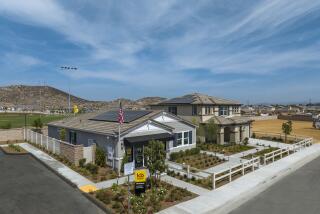Apartments to Use Two-for-One Energy
- Share via
The “twofer” has become an established merchandising technique, basically “two for the price of one,” but with innumerable variations.
One twofer that’s not just a sales gimmick goes by the formal name of co-generation and is being more and more widely used. A recent installation--so recent that it’s still being installed--is at a large apartment complex nearing completion in Huntington Beach.
Co-generation could also be called “putting two loads on the same burro.” In its most common form, when fuel is burned to make electricity, the heat from the burning is trapped and used to warm things; that is, the gallon of gasoline or diesel fuel that turns the generator to make X number of watts of electricity also warms the dish and bath water.
The Huntington Breakers, 21270 Beach Blvd., is a couple of hundred yards inland from Pacific Coast Highway, which at that point runs right along the beach. Four phases of the 342-unit complex have been completed and construction of the fifth is well along.
Leasing stood at 212 apartments when the 100-unit fourth phase opened Sept. 19; that figure included the first three phases and some pre-leasing in the fourth. The fifth and final phase of 65 units is scheduled to open Nov. 1.
Apartments range from one-bathroom bachelor studios of about 500 square feet to two-bedroom, two-bath town house-style units of 920 square feet. Rents in the first four phases run from $695 to $980; the final phase, which has the best ocean views, may have a different rent schedule.
The water- and space-heating systems for the complex and its electrical supply are based on a modular, packaged co-generation system called Tecogen by its manufacturer, Thermo Electron Corp., Waltham, Mass.
Each capsule contains an engine similar to the gasoline engine in your car (bigger, of course) but fueled by natural gas. It turns a 60 kilowatt electric generator that is packaged into the module and is controlled by a microprocessor. Heat exchangers draw off the engine’s heat from three sources, the exhaust manifold, the engine block and the oil cooler.
The Breakers is installing three modules for a total of 180 kilowatts of generating capacity, enough to furnish electricity for the regular operation of the complex--lighting the grounds and common areas such as the recreation room, for example. Each apartment is separately metered for its own electricity and gas, which are purchased directly from the utilities and paid for individually by the tenants.
The modules also keep a 5,000-gallon insulated storage tank filled with hot water. That water is then pumped through continuous loops--there are seven of them, each serving about 40 apartments--where it goes through fan coils for space heating and is tapped by residents for domestic hot water. The cooled water returns to the storage tank through a heat exchanger coupled to the co-generation modules and is reheated.
The use of either co-generation or solar was planned from the beginning, according to Malcolm Lewis of Irvine-based Malcolm Lewis & Associates Engineers Inc., the project’s mechanical and electrical engineer working with the architect, Phelps Morris Associates of Long Beach.
The reason it is late in being installed, he explained, is that decisions were delayed as to the financing of the co-generation system. But the developers were anxious to get the complex built and rented, so they went ahead with construction, using the planned back-up system for heat and power until the co-generation plant is completed. It is scheduled to be operating by the end of the year.
“We studied solar, co-generation and conventional systems,” he said, “and the economics came out best for co-generation. Surprisingly--at least it surprised us--it was better than solar!”
He cited information from Thermo Electron, based on costs of electricity at 8 cents a kilowatt hour and gas at $5 per million BTUs (British thermal units--a measure of heat production or consumption). It showed that 60 kilowatts of electricity and 440,000 BTUs of hot water per hour would cost $8.46 per hour from a conventional system and $4.88 per hour by co-generation.
“We calculated that electricity and hot water for this complex would cost the developers about $200,000 a year with a conventional system,” Lewis said. “With co-generation the cost would be $100,000 to $110,000.
“The payoff period (the time in which savings equal the initial cost of the installation) for co-generation figures out to about four years. But that’s without considering the tax benefits--the energy credit, investment tax credit and so forth. With them, the payoff will be under three years.”
Lewis will monitor the system with the gas company for two years “to see how the predicted loads compare with the real loads in practice.”
The owner-developer of the Breakers is Huntington Breakers Ltd., a partnership of Wilmore City Development Co. of Santa Ana and Joseph P. Mayer III of Brentwood. The general contractor is C. W. Driver of Los Angeles and the property is managed by Regis Management of Newport Beach.
Lewis had some thoughts about co-generation. Emphasizing that he hasn’t made a detailed study but is working on a “gut feeling,” he said the best bets for co-generation would be projects of at least 100 to 150 units, with central water and space heating, and a density of at least 10 units per acre.
When the Hotel Del Coronado in the San Diego area was mentioned as one of the most widely known institutions that has adopted co-generation, he said, “A hotel is ideal. In addition to the rooms and lobbies, you have a big kitchen operation and a laundry operation.”










